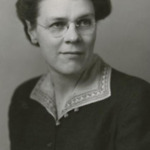Interviewer: Sheri Lowery
Interview Date: June 2, 1983
Location: Corvallis, Oregon
Duration: 0:36:37
In this interview, Clara Storvick discusses her professional life doing research at Oregon State University. She is accompanied by her colleague, Dr. Margaret Fincke, who also participates in the interview.
Storvick begins by briefly discussing her research projects when she first came to OSU in 1945, noting that a project on Vitamin B6 probably had the most profound effect on her. She then describes the function of Vitamin B6 in the human immune system and why infants, rather than adults, are susceptible to a deficiency in Vitamin B6.
Storvick also notes that, before she was appointed as chair of Home Economics Research the OSU Experiment Station in 1965, she was more involved with nutritional research. As examples, she cites studies in clothing and textiles and their connections to Home Economics. Storvick also describes a research project in which a local zoo contacted her about food requirements for a newborn elephant. From there, Storvick suggests that, within her twenty-five years of working at OSU, there have been changes in scope and depth, but not necessarily in the general plans of study.
Dr. Margaret Fincke then recounts a vacation that she and Storvick took in which they experimented with an ascorbic acid-deficient diet as part of their combined research study. Storvick also notes that she and Fincke climbed Mt. Rainer in 1946 together, but currently spend their free time gardening and doing volunteer work. Storvick also recalls various sabbatical leaves and comments on how OSU's connections abroad are very strong compared to other universities. Storvick specifically mentions a Finnish student of hers who used to work in a Soviet prison work camp but eventually became a Finnish diplomat in the Panama Canal Zone.
Next, Storvick describes her and Fincke’s volunteer work at the Medical Records Department in the Corvallis hospital and Fincke briefly talks about her other volunteer work delivering meals to the elderly. The interview concludes with both women commenting on their enjoyment of retirement.
Dublin Core
Title
Description
Storvick begins by briefly discussing her research projects when she first came to OSU in 1945, noting that a project on Vitamin B6 probably had the most profound effect on her. She then describes the function of Vitamin B6 in the human immune system and why infants, rather than adults, are susceptible to a deficiency in Vitamin B6.
Storvick also notes that, before she was appointed as chair of Home Economics Research the OSU Experiment Station in 1965, she was more involved with nutritional research. As examples, she cites studies in clothing and textiles and their connections to Home Economics. Storvick also describes a research project in which a local zoo contacted her about food requirements for a newborn elephant. From there, Storvick suggests that, within her twenty-five years of working at OSU, there have been changes in scope and depth, but not necessarily in the general plans of study.
Dr. Margaret Fincke then recounts a vacation that she and Storvick took in which they experimented with an ascorbic acid-deficient diet as part of their combined research study. Storvick also notes that she and Fincke climbed Mt. Rainer in 1946 together, but currently spend their free time gardening and doing volunteer work. Storvick also recalls various sabbatical leaves and comments on how OSU's connections abroad are very strong compared to other universities. Storvick specifically mentions a Finnish student of hers who used to work in a Soviet prison work camp but eventually became a Finnish diplomat in the Panama Canal Zone.
Next, Storvick describes her and Fincke’s volunteer work at the Medical Records Department in the Corvallis hospital and Fincke briefly talks about her other volunteer work delivering meals to the elderly. The interview concludes with both women commenting on their enjoyment of retirement.

